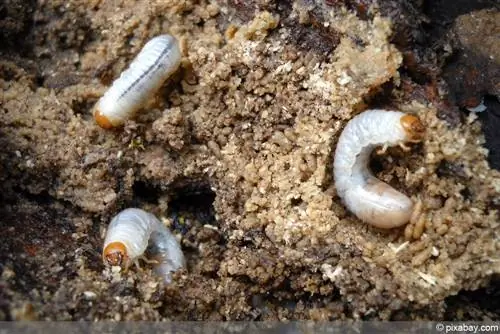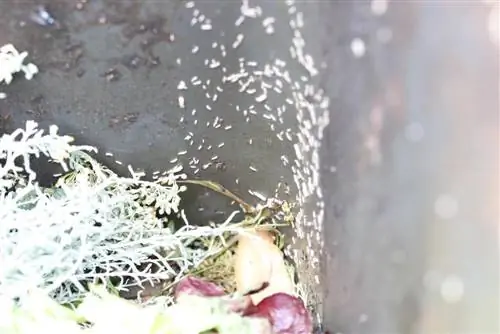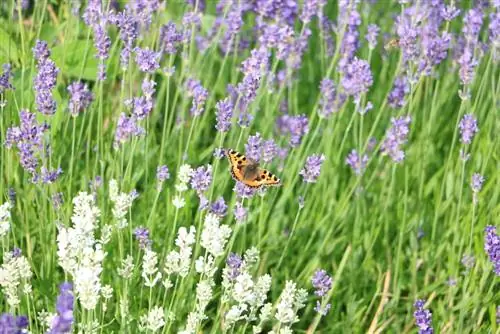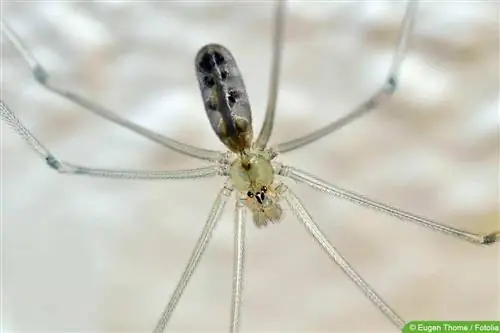- Author admin [email protected].
- Public 2023-12-17 03:39.
- Last modified 2025-01-24 12:45.
Anyone who has a garden usually also has a composter. But if the wrong materials are disposed of here, excessive maggot formation can quickly occur. In addition to the strong odor, the resulting compost can no longer be used as fertilizer, otherwise many pests would be spread throughout the garden and harm the plants. Therefore, grubs, larvae and maggots should be combated.
Definition maggots
The term maggots primarily refers to the fly larvae that are born from laid eggs or directly. These have a bad reputation because they are mainly found in organic materials such as spoiled food, garbage, feces or on unprotected, fried meat. These maggots have different sizes and can be recognized by the fact that they appear in large quantities and “scurry about on top of each other”. If maggots are found in the compost, this is usually the reason why bad smells come from the composter. After a short time, the larvae pupate and become flies, which then lay their eggs again.
Tip:
Fly maggots generally do not harm plants in the garden because they feed on organic waste. Therefore, it is not a tragedy if these are unknowingly distributed in the garden with the fertilizer. If these are buried underground, they usually die.
Definition of grubs
Grubs are white, thick larvae that are usually found in a horseshoe shape. They can grow up to six centimeters long and the bodies are either orange-brown or light gray. There are also three pairs of legs in the front area. They come from various beetles, some of which can be quite harmful to the garden, while other species are not. But if the grubs are found in the composter, it is difficult to determine whether they are harmful. Some species only feed on plant remains, but others also feed on living roots. The following beetles lay their eggs on the compost:
- May beetle, very harmful to roots
- Rose beetle, feeds on plant remains
- scarf beetle
- Ribbed curlew beetles
- various other beetles

Grubs do not occur as frequently as maggots do. Therefore, when sighted, these can often be removed with a gloved hand and placed in a bowl for the birds.
Tip:
If you find grubs in the compost, you should sift it well before fertilizing the garden so that none of the harmful grubs are buried underground and, in the worst case, could destroy newly planted plants.
What belongs in the compost?
A compost heap should not be missing in any garden. But often the wrong things are put in, which can lead to increased maggot formation, especially in the hot summer months. Especially if the organic materials are not compostable, they have no place in the compost and attract flies and beetles even more to lay their eggs. Therefore, the first measure to prevent maggots from forming in compost is proper separation. Only the following garden and kitchen waste should be put into the composter:
- Leftover vegetables and fruit
- Coffee or tea grounds with bag and filter
- Dung from herbivorous small animals
- crushed flower scraps
- chopped shrub or tree cuttings
- Leaves
- crushed eggshells
- Lawn and grass clippings
- Moss
- Tree needles
- Fallen fruit
All other materials such as baby diapers, ashes, cooked food leftovers or even cat and dog feces have no place in a composter and, above all, magically attract pests and their larvae.
Tip:
Weeds are actually decomposable, but should not be put in the composter. This way they can spread throughout the garden the next time you fertilize, even if the seeds have ended up in the composter.
Prevention

Using a compost heap correctly is the best prevention against fly larvae, maggots or grubs. In addition to filling it correctly, it also makes a lot of sense to prevent moisture in the composter itself. Because it can be very wet in these latitudes, especially during the autumn, winter and even spring months. But it is precisely because of this moisture that the number of maggots increases. Because they need a moist climate to develop. Therefore, care should be taken to ensure that the compost is dry. There are the following options for this:
- Composters from stores are already rainproof
- otherwise protect from rain with a cover
- Mix the materials into the filling
- anything that absorbs moisture is suitable
- Sawdust
- Cardboard egg cartons
- newsprint
- Primitive rock powder or bentonite
So that the moisture and thus maggot infestation stays out, you should avoid putting wet leaves, wet lawn clippings or wet plant residues in the composter. Everything should be dried thoroughly before it is disposed of.
Good bird food
All domestic bird species prefer maggots as food. It is therefore important to have lots of birds in the garden in addition to a composter. If the songbirds find nesting places in the immediate vicinity, then they sit directly at the source. Many niches, hedges and nesting boxes for the birds can be created around the compost heap. The compost can then be mixed regularly so that the maggots come to the surface and are readily accepted as food by the birds. The larger specimens can also simply be picked up with gloved hands and provided to the birds in a bowl as food.
Home remedies for maggots
There are various home remedies that are supposed to help against larvae etc. if the compost is already infected. Of course, these must be completely compatible with the resulting fertilizer for the garden. The following home remedies can be used well to free already infested composters
- Fix lime and sprinkle directly on the pests
- do the same with silica
Tip:
S alt is also often suggested as a home remedy. However, s alt should not be used in the resulting fertilizer in the composter, as it can cause lasting damage to the plants after fertilization via the roots, as is often caused by road s alt in winter.
Do not use chemicals
Even though there are many chemical weapons against maggots, larvae, etc., they are not suitable for the composter. Because what breaks down and is created here will later serve as natural fertilizer in the garden. However, if chemicals such as bleach or carburetor cleaner are used, then all of the compost becomes unsuitable as fertilizer. Therefore, the use of chemicals should be avoided in any case.
Removing compost
If neither the prevention nor the home remedies against the larvae have helped, then the fertilizer for the garden year is unfortunately lost and should be removed and disposed of altogether. It is important that the maggots are also destroyed. Depending on how high the compost heap is and how large it is, the leftovers can be sealed airtight in plastic bags and disposed of with residual waste or household waste. If the area is larger, you can pour boiling water over it before disposal, which can also kill the larvae. Once all residues have been removed, proceed as follows:
- clean the composter well
- wash well with vinegar solution
- then let it dry out thoroughly
- Reconsider location
- Is it too warm or too wet at the location
- Make sure the filling is correct when refilling
Tip:
Beetle larvae cannot generally be avoided as they like to be deposited in plant residues, while fly larvae only appear in the composter if it has been filled incorrectly, for example with meat-based food waste.
Plants around the compost

So that the flies are not even tempted to lay their eggs in the composter, they can also be repelled with various smells. To do this, it is helpful to plant various plants around the compost heap whose smells the flies don't like. This also has the positive effect that the composter can be decorated decoratively in the corner. The flies can be driven away by the following smells:
- Basil
- Lavender
- Peppermint
- Incense
- Eucalyptus
- Laurel
- Marigolds
- Geraniums
It is also helpful to regularly add leftovers from these plants to the composter so that the smell from the inside drives away the flies or does not attract them in the first place. However, these products are not suitable for the deposition of beetle larvae, which are generally not distracted by these smells.
Tip:
A compost heap in a corner of the garden can look quite unattractive. But a beautifully laid out herb bed with a small laurel bush in the middle looks extremely decorative. The same applies if buckets with flowering plants are distributed around the composter and a bird house is set up nearby.






